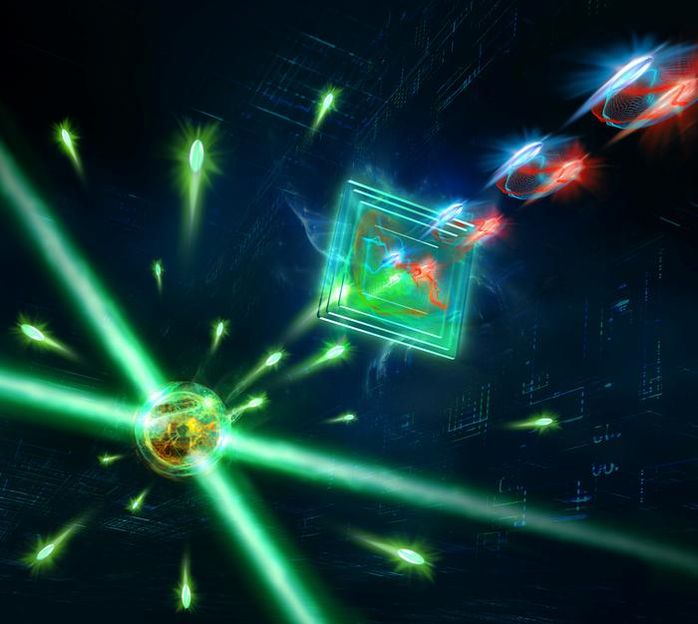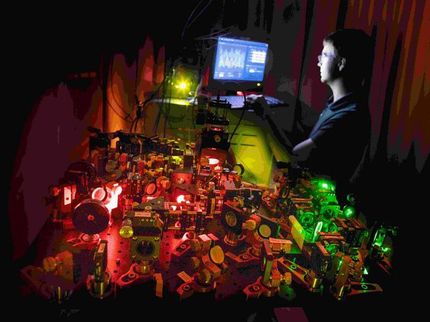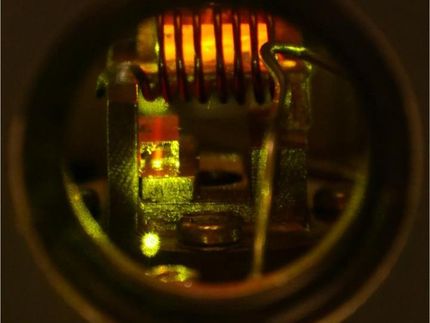Singles become pairs: New insights into the light scattering of atoms
Researchers at the Humboldt University of Berlin, partners of the DAALI project, have demonstrated a surprising effect present in the fluorescent light of a single atom
Advertisement
Researchers headed by Jürgen Volz and Arno Rauschenbeutel from the Department of Physics at the Humboldt University of Berlin, partners of the DAALI project, have gained new insights into the scattering of light by a fluorescent atom, which could also be useful for quantum communication. The research team has now published their results in the scientific journal Nature Photonics.

A single atom is excited by laser light and scatters one photon after another. An optical filter removes certain colour components from this stream of single photons. This causes the remaining photons to become pairs that leave the filter simultaneously. (Image: Department of Physics, Humboldt-Universität zu Berlin).
Department of Physics, Humboldt-Universität zu Berlin
In 1900, Max Planck formulated the hypothesis that light cannot exchange arbitrary amounts of energy with matter, such as an atom, but only certain discrete "energy packets" called quanta. Five years later, Albert Einstein then proposed that these quanta were not a mere computational quantity, but that light itself consisted of quanta, which we now call photons. In fact, nowadays there are photodiodes which are sensitive enough to register a single photon. With continuous illumination, these do not produce a steady electrical signal, but rather a series of short current pulses. Each current pulse then indicates the detection of a single photon.
Under the magnifying glass: scattering of laser light
If the light of a single atom, which is excited to fluoresce by a laser beam, hits such a highly sensitive photodiode, two photons will never be detected simultaneously. In this respect, the fluorescent light from a single atom differs from the laser light with which it is excited, as photons do indeed occur simultaneously in laser light. But if two laser photons impinge on a single atom at the same time, the atom will absorb only one photon and allow the second to pass. Subsequently, the atom will radiate the absorbed laser photon in a random direction, and only then will it be ready to absorb another laser photon.
In other words, a single atom can scatter only one photon at a time, and the photons in the fluorescent light of a single atom strike the detector as if lined up like pearls on a string. This property is exploited within the DAALI project and other research on quantum technologies. For example, in quantum communication, single photons emitted by natural or artificial atoms are used for tap-proof communication.
Through the filter: single photons become pairs
However, the research team at the Humboldt University have now been able to demonstrate a very surprising effect using the fluorescent light of a single atom. When the researchers removed a certain colour component from the light with the help of a filter, the single photon stream transformed into pairs of photons that were detected simultaneously.
Thus, by removing the correct ones from a stream of single photons, the remaining photons suddenly appear as pairs. This effect cannot be reconciled with the perception of our everyday world; if you ban all green cars from a street, the remaining ones do not suddenly drive in pairs next to each other. Additionally, the former certainty that a single atom can only scatter one photon at a time also seems to have been disproved: when viewed through the right colour filter, the atom is very well able to scatter two photons at the same time. This effect was predicted about 40 years ago by Jean Dalibard and Serge Reynaud at ENS Paris in their theoretical work on the scattering of light by atoms. However, it has only now been experimentally demonstrated by the team led by quantum physicists Jürgen Volz and Arno Rauschenbeutel.
"This is a wonderful example of the extent to which our intuition fails us when we try to get an idea of how processes occur at the microscopic level," says Jürgen Volz. "However, this is much more than just a curiosity," adds Arno Rauschenbeutel. "Indeed, the photon pairs generated are quantum mechanically entangled. So there is the spooky action at a distance between the two photons that Einstein didn't want to believe in and thanks to which one can teleport quantum states, for example." "That a single atom is ideally suited as a source for such entangled photon pairs," Volz and Rauschenbeutel agree, "is something hardly anyone would have believed until recently."
In fact, the demonstrated effect lends itself to realizing sources of entangled photon pairs whose brightness reaches the theoretically possible maximum and thus surpasses existing sources. Furthermore, the photon pairs inherently match the atoms from which they were emitted. This allows one to directly interface the photons with quantum repeaters or quantum gates which use the same atoms and are required for long-distance quantum communication.
Original publication
Luke Masters, Xin-Xin Hu, Martin Cordier, Gabriele Maron, Lucas Pache, Arno Rauschenbeutel, Max Schemmer, Jürgen Volz; "On the simultaneous scattering of two photons by a single two-level atom"; Nature Photonics (2023)

































































